Bibliography Background About KRIS
Hypothesis #1: Both the distribution and abundance of coho salmon in the Noyo River basin have been reduced significantly between the 1960s and 1990s.
Support for the hypothesis rom the literature
Burns (1972) sampled the Little North Fork Noyo River in 1966, 1968 and 1969 and found that coho salmon far outnumbered steelhead. Valentine and Jameson (1994) repeated Burns' study and found that in 1992 "the species composition inverted from primarily coho salmon to primarily steelhead trout". Manning (2000) noted that coho densities remained low in the Little North Fork Noyo River between 1994 and 1996 and that production of juvenile coho salmon was the lowest per kilometer of stream of the six streams he studied in northern California. California Department of Fish and Game stream survey reports from the Noyo River watershed from the mid-1960s provide baseline data showing that coho salmon were either dominant or comprised a significant portion of the juvenile salmonid population. Recent data, both from CDFG and the Mendocino Redwood Company show that coho salmon are subordinate to steelhead, or in some cases are at remnant levels or absent altogether.
Data from the Noyo Basin
Source Topics: The charts below are derived from the Topics listed here. Check these Topics in the KRIS database to see the information in context and to have access to InfoLinks and Metadata.
(MN) Fish: Little NF Noyo Biomass for Coho vs. Steelhead, 1966-69 vs. 1992
(NF) Fish: CDFG North Fork Noyo 1967 Net Samples
(NF) Fish: NF Noyo E-fishing/Snorkling 1995 (All Tribs), by MRC
(NF) Fish: NF Noyo E-fishing/Snorkling 1996 (All Tribs), by MRC
(MN) Fish: Duffy Gulch CDFG 1967 Net Samples
(MN) Fish: Duffy Gulch E-fishing, 1986 by CDFG
(UN) Fish: CDFG Olds Creek 1967 Net Samples
(UN) Fish: Olds Creek E-fishing, 1996 by MRC
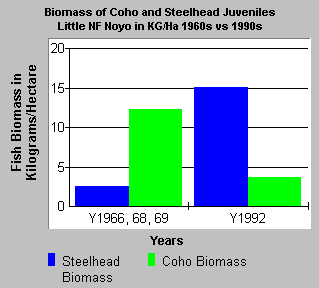 |
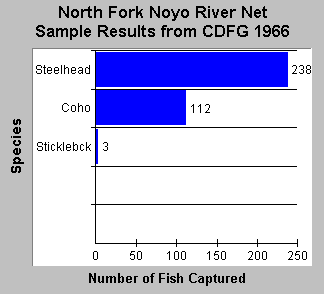 |
|---|---|
| The chart above from KRIS/Noyo shows that the fish community in the Little North Fork Noyo River was dominated by juvenile coho salmon in the mid- to late-1960s but had shifted to one dominated by juvenile steelhead by 1992. (Data from Burns, 1972, and Valentine and Jameson, 1994). | California Department of Fish and Game net surveys in the North Fork Noyo River in 1966 showed that juvenile coho salmon were less numerous than steelhead trout but that they comprised a substantial component of the community. Data from CDFG (1967g). |
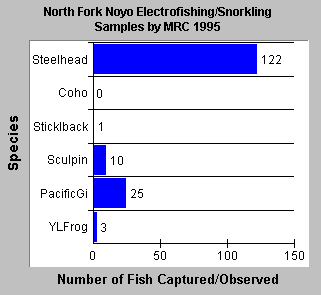 |
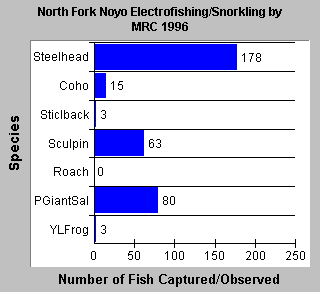 |
|---|---|
| A pooled compilation of all fish samples taken by the Mendocino Redwood Company in the North Fork Noyo River in 1995 showed that juvenile coho were not captured in any sample. This is a substantial change from the fish community structure in 1966. | Mendocino Redwood Company samples in the North Fork Noyo River in 1996 showed that coho juveniles were present but that they were out-numbered by steelhead by over 10:1. This is much different than the 2:1 ratio between these species found by CDFG in 1966. |
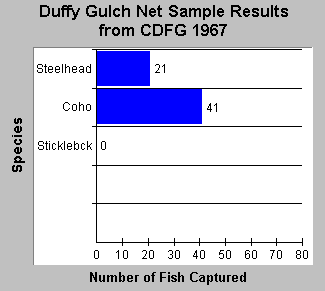 |
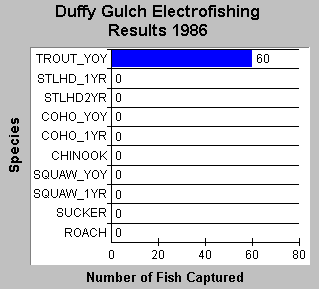 |
|---|---|
| California Department of Fish and Game samples in 1966 found twice as many coho juveniles as steelhead in Duffy Gulch, a Middle Noyo Basin tributary. Data from CDFG (1967a). | When the California Department of Fish and Game re-sampled Duffy Gulch in 1986, no juvenile coho were captured. The TROUT_YOY are most likely steelhead young of the year. |
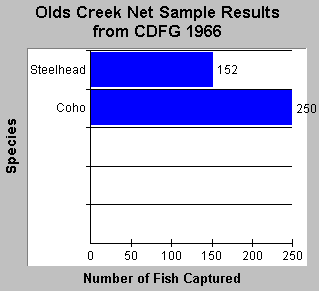 |
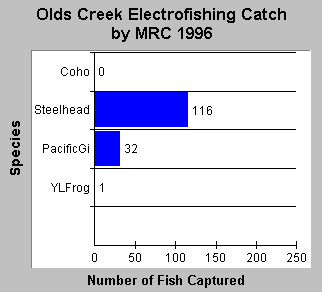 |
|---|---|
| The California Department of Fish and Game sampled Olds Creek with nets in 1966 and captured more juvenile coho salmon than steelhead. Data from CDFG (1967h). | Olds Creek was sampled by the Mendocino Redwood Company in 1996 and no coho salmon were found. The 1966 and 1996 Olds Creek fish samples support the hypothesis that fish distribution and abundance of coho salmon has changed between the 1960s and the 1990s. |
 This image is from a KRIS Noyo Map project and it shows the relative abundance of coho salmoon and steelhead juveniles in the Noyo River watershed and Pudding Creek in the 1960s based on California Department of Fish and Game fish samples. Samples showing more coho than steelhead were characterized as coho dominated with steelhead present but sub-dominant (light blue). Some CDFG surveys indicated equal numbers of steelhead and coho and these are characterized as co-dominant and colored light green. A few higher gradient tributaries such as the North Fork Noyo, Redwood Creek and Hayworth Creek had more steelhead in samples than coho. These areas were characterized as having steelhead as the dominant species with coho sub-dominant (yellow). There were no basins where coho were at very low levels or absent (red). Gray areas of the map show where survey data is lacking. Click the thumbnail picture to see the image.
This image is from a KRIS Noyo Map project and it shows the relative abundance of coho salmoon and steelhead juveniles in the Noyo River watershed and Pudding Creek in the 1960s based on California Department of Fish and Game fish samples. Samples showing more coho than steelhead were characterized as coho dominated with steelhead present but sub-dominant (light blue). Some CDFG surveys indicated equal numbers of steelhead and coho and these are characterized as co-dominant and colored light green. A few higher gradient tributaries such as the North Fork Noyo, Redwood Creek and Hayworth Creek had more steelhead in samples than coho. These areas were characterized as having steelhead as the dominant species with coho sub-dominant (yellow). There were no basins where coho were at very low levels or absent (red). Gray areas of the map show where survey data is lacking. Click the thumbnail picture to see the image.
 This image is from a KRIS Noyo Map project and shows the balance between coho and steelhead juveniles in Noyo River sub-basins and Pudding Creek in the 1990s. The map is based on electrofishing and dive counts conducted by CDFG and the Mendocino Redwood Company. Coho dominated samples (light blue) were restricted to Bear Gulch, a South Fork Noyo River tributary. Most other sub-basins showed a considerable shift from the 1960s. Many sub-basins formerly dominated by coho are now dominated by steelhead with coho still present but sub-dominant (yellow). Other sub-basins have only a few coho in samples or coho are absent in some years. This latter category is steelhead dominant and coho remnant or absent (red). Sub-basins with no data are colored gray.
This image is from a KRIS Noyo Map project and shows the balance between coho and steelhead juveniles in Noyo River sub-basins and Pudding Creek in the 1990s. The map is based on electrofishing and dive counts conducted by CDFG and the Mendocino Redwood Company. Coho dominated samples (light blue) were restricted to Bear Gulch, a South Fork Noyo River tributary. Most other sub-basins showed a considerable shift from the 1960s. Many sub-basins formerly dominated by coho are now dominated by steelhead with coho still present but sub-dominant (yellow). Other sub-basins have only a few coho in samples or coho are absent in some years. This latter category is steelhead dominant and coho remnant or absent (red). Sub-basins with no data are colored gray.
Alternate Hypotheses
The observed change in the fish community structure between coho and steelhead is within the natural range of variability.
Valentine and Jameson (1994) advance this hypothesis in the conclusion of their report. It could be further explored in the same way as Hypothesis 1 (see below).
Monitoring Trends to Test the Hypotheses
Unless additional historical data is discovered, which doesn't appear likely at this point, the only way to test these alternate hypotheses is to continue monitoring the streams where we have historical data, like the Little North Fork Noyo River, to determine over the years whether coho consistently dominate in the cooler streams, as Burns (1972) observed, or whether coho and steelhead take turns dominating as suggested by Valentine and Jameson (1994).
References
Burns, J. 1972. Some Effects of Logging and Associated Road Construction on Northern California Streams. Transactions of the American Fisheries Society, Vol. 101, No. 1: 1-17.
California Department of Fish and Game. 1966. Dewarren Creek Stream Survey Report, 8/23/66. Region 3, CDFG, Yountville, CA. 2 p.
California Department of Fish and Game. 1967a. Duffy Gulch Stream Survey Report, 8/26/66. Region 3, CDFG, Yountville, CA. 2 p.
California Department of Fish and Game. 1967b. Hayworth Creek Stream Survey Report 8/22/66. Region 3, CDFG, Yountville, CA. 4 p.
California Department of Fish and Game. 1967c. Kass Creek Stream Survey Report, 8/24/66. Region 3, CDFG, Yountville, CA. 2 p.
California Department of Fish and Game. 1967d. Marble Gulch Stream Survey Report, 8/16/66. Region 3, CDFG, Yountville, CA. 2 p.
California Department of Fish and Game. 1967e. McMullen Creek Stream Survey Report, 8/10/66. Region 3, CDFG, Yountville, CA. 3 p.
California Department of Fish and Game. 1967f. Middle Fork North Fork Noyo River Stream Survey Report, 8/18/66. Region 3, CDFG, Yountville, CA. 2 p.
California Department of Fish and Game. 1967g. North Fork Noyo River Survey Report, 8/17/66. Region 3, CDFG, Yountville, CA. 3 p.
California Department of Fish and Game. 1967h. Olds Creek Stream Survey Report, 8/9/66. Region 3, CDFG, Yountville, CA. 2 p.
California Department of Fish and Game. 1967i. Redwood Creek Stream Survey Report, 8/14/66. Region 3, CDFG, Yountville, CA. 4 p.
Manning, D.J. 2000. Carrying Capacity and Limiting Habitat Analysis for Coho Salmon (Oncorhynchus kisutch) in Streams of Northwestern California. Masters Thesis, Humboldt State University, Arcata, CA. 111p.
Valentine, B.E. and M. Jameson. 1994. Little North Fork Noyo Fishery Study, 1992. CA Department of Forestry and Fire Protection, Coast Cascade Region. Santa Rosa, CA. 48 pp.